

Cont017. EMC & EMI Test-Antennas, Activ directional Antennas, RF Near Field Probe Sets. Position:Home »Products »Antennas 1Hz (3)5Hz (4)10Hz (5)100kHz (3)20MHz (13)30MHz (17)50MHz (18)380MHz (23)400MHz (29)680MHz (35)700MHz (42) 1kHz (5)100kHz (3)1MHz (3)30MHz (17)700MHz (42)1GHz (40)2,5GHz (31)3GHz (25)4GHz (22)6GHz (18)8GHz (12)10GHz (6)18GHz (2) Directional Antennas (24)Passiv Directional Antennas (12)Active Directional Antennas (8)Highend EMI-Antennas (2)Biconical Antennas (15)Probes & Sensors (6)Isotrope / Radial isotrope (2)Near-field measurement (2)Conductive measurement (2)Vibration measurement (2)GSM900 (39)GSM1800 (30)GPS (28)Microwave (24)UMTS/3G (30)DECT (28)2,4GHz WLan (28)5-6GHz WLan (14)Tetra/BOS (22)ISM433 (26)ISM868 (26)Radar (0)Radio broadcasting (UKW) (15)TV broadcasting (VHF) (15)TV broadcasting (UHF) (28)Citizen Band radio (11)UWB (FB1) (6)UWB (FB2) (22)UWB (FB3) (19)UWB (FB4) (19)UWB (FB5) (15)UWB (FB6) (15)UWB (FB7) (15)UWB (FB8) (6)UWB (FB9) (2)UWB (FB10) (2) Searchresults: Near Field Probes & RF Sniffer.
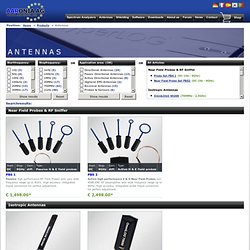
Fractal HF antenna: science or fiction ? When I first got interested in Amateur Radio, I quickly realized that antennas were one of the most important components in an efficient radio station.
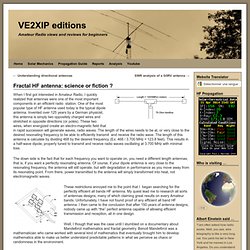
One of the most popular type of HF antenna used today is the typical dipole antenna. Invented over 125 years by a German physicist, this antenna is simply two oppositely charged wires and stretched in opposite directions (or poles). These two wires, when energized create an electro-magnetic field that in rapid succession will generate waves, radio waves. The length of the wires needs to be at, or very close to the desired resonating frequency to be able to efficiently transmit and receive the radio wave. The length of this antenna is calculate by dividing 468 by the desired frequency (Ex: 468 / 3.700 MHz = 123.8 feet).
The down side is the fact that for each frequency you want to operate on, you need a different length antennas, that is, if you want a perfectly resonating antenna. Here is a portion of that documentary; Amateur Radio views and reviews for Beginners. Amateur Radio views and reviews for Beginners. Neets - Naval Electrical Engineering Training Series. Neets Module 09-Introduction to Wave-Generators and Wave-Shaping Circuits. Neets Module 19-The Technicians Handbook. Enter - Power Density Calculator. Amateurs are required to perform a routine evaluation of the strength of the RF fields around their stations, subject to certain exemptions based on peak envelope power (PEP) levels at the various amateur bands.
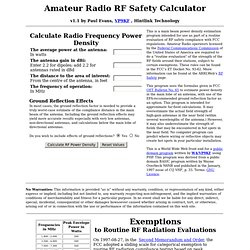
However, the FCC regulations on permissible RF exposure are not based on peak envelope power (PEP), but on average power over a 30-minute time period for uncontrolled environments, or a 6-minute time period for controlled environments. The part of the regulations that determine whether a station operator must perform a periodic evaluation, however, is based on PEP. To estimate your average power, first start with your Peak Envelope Power (PEP).
Multiply that by the duty factor for the mode you are using, then by the maximum percentage of time you expect to operate within the averaging period.
HexBeam. Ham & Amateur Radios - Equipment, Parts and Supply. CQ - 'The Authority on Amateur Radio' for more than 65 years. Amateur Radio Antenna Projects. Guests Rooms. Home Page. Antenna Links. Tips for DX stations and DXpeditions. Do you enjoy a combined family and radio holiday ?
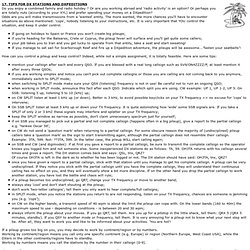
Or are you working abroad and 'radio activity' is an option? Or perhaps you are totally nuts (according to your XYL) and prefer spending your money on a DXpedition? Odds are you will make transmissions from a 'wanted' entity. The more wanted, the more chances you'll have to encounter situations as above mentioned: 'cops', nobody listening to your instructions, etc. It is very important that YOU control the situation, and keep it under control. If going on holidays to Spain or France you won't create big pileups; if you're heading for the Baleares, Crete or Cyprus, the pileup fever will surface and you'll get quite some callers; your job takes you to Iran and you get lucky to operate from that entity, take a seat and start sweating! How can you control a pileup and keep control? Mention your callsign after each and every QSO. If a pileup grows too big on you, you may decide to work by continent/region or by numbers.
Stealth Amateur Radio. In the episode of the famous TV comedy series "Hancock's Half Hour" called "The Radio Ham", Tony Hancock says: "It's a wonderful hobby.
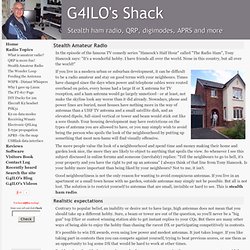
I have friends all over the world. None in this country, but all over the world! " If you live in a modern urban or suburban development, it can be difficult to be a radio amateur and stay on good terms with your neighbours. Times have changed since the days when power and telephone cables were routed overhead on poles, every house had a large H or X antenna for TV reception, and a ham antenna would go largely unnoticed - or at least, not make the skyline look any worse than it did already. Nowadays, phone and power lines are buried, most houses have nothing more in the way of antennas than a UHF TV antenna and a small satellite dish, and an elevated dipole, full-sized vertical or tower and beam would stick out like a sore thumb. Good neighbourliness is not the only reason for wanting to avoid conspicuous antennas.